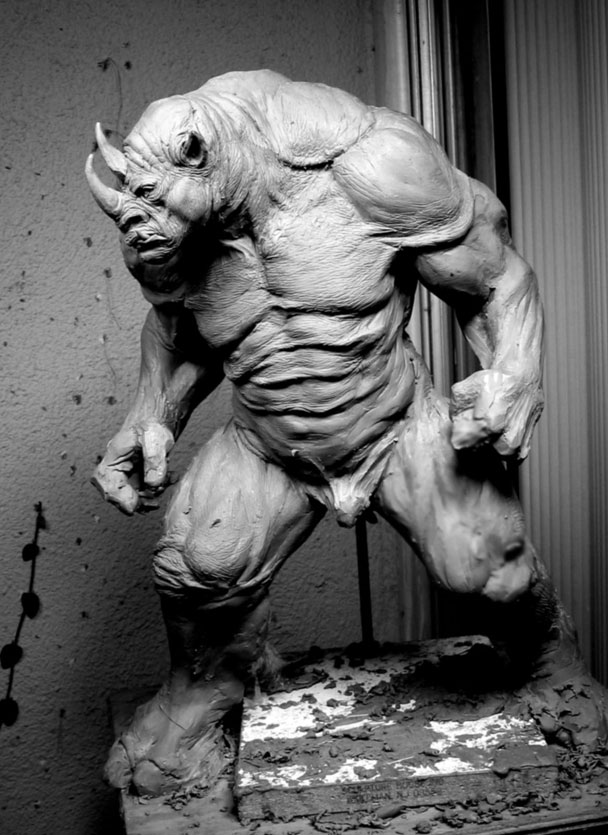PC Race – Robots
Requirements: none Prime Requisite: CON Hit Die: 1d8 Maximum Level: 10
Robots are uncommon
in the anomalous world, but the ancients made vast numbers of them (“Why do the scientists keep making them?”) and many have been reactivated. While robots in general vary widely in size
and capability, all player character robots are humanoid in shape and
size. Robots are distinguished from
computers by having positronic brains, endowing them with a degree of will and
flexibility not seen in even the most powerful conventional AI.
A robot PC is not an
especially rugged or dangerous model at first but as it gains levels the robot improves
itself with new parts, motors, sensors, and weapons. These are built from random bits scavenged from
other robots, found in storage, or purchased from Scientists. A robot does not wear conventional armor,
doing so interferes with their sensors.
They may wield any weapon or shield as a human does. All robots start with an unarmed attack that
does 1d4 damage. This can be a pincer,
drill, simply a blow from a metal hand, or whatever seems appropriate.
Robots are immune to
poison, disease, parasites, and ‘person’ affecting magic. Their positronic circuitry is sensitive to
negative energy, meaning robots can lose levels, and they need oxygen for catalytic
reactive purposes—basically the same as people need to breathe. Robots attacked by rust monsters or similar
effects take a 2d8 points of damage from each ‘hit’.
|
|
Level
|
XP
|
HD
|
THAC9
|
Robo-Points™
|
AC
|
|
1
|
0
|
1
|
10
|
1
|
9
|
|
2
|
2500
|
2
|
10
|
2
|
8
|
|
3
|
5000
|
3
|
10
|
3
|
7
|
|
4
|
10,000
|
4
|
9
|
3
|
6
|
|
5
|
25,000
|
5
|
9
|
4
|
5
|
|
6
|
50,000
|
6
|
8
|
4
|
4
|
|
7
|
100,000
|
7
|
8
|
5
|
3
|
|
8
|
200,000
|
8
|
8
|
5
|
2
|
|
9
|
350,000
|
9
|
7
|
7
|
1
|
|
10
|
500,000+
|
10
|
7
|
7
|
0
|
RoboPoints™ and robot advancement: when a robot gains a level it gains RoboPoints
that can be spent on various improvements.
There is some expense, 100 GP of robot parts per RoboPoint spent. The
first time an improvement is purchased it costs 1 RoboPoint. Buying it again costs 3 points, then 5, then
7. Most improvements are limited to four
‘levels’.
StatBoost: adds 1d3
to any ability score to a maximum of 18.
Each score is a separate improvement.
MultiSwing: adds one
unarmed attack per round. Every level
beyond the first represents an extra arm as well. No more than three levels can be
purchased. The first level of this
improvement costs 3 RoboPoints, then 5, then 7.
No extra attacks are gained with weapons held, only unarmed attacks.
HitBoost: improves
the robot’s unarmed attack damage by a die type (d6, d8, d10, then d12). This can represent buzz saws, retractable
spikes or blades, etc.
HoverJets: Repulsor
motors allow the robot to hover, and at higher levels thrusters allow forward
movement. Max height equals 15’ x
improvement level. Speed equals 20 x
(improvement level – 1).
Built-in ranged
weapon: the weapon must be provided. It
can be a crossbow, gun, or energy weapon.
Ammunition must be provided. All
built in ranged weapons can be fired as a single action. This improvement can only be purchased three
times.
Modularity: doubles
the effects of normal repairs (x3, x4, x5 at higher levels). Each level purchased also allows the robot to
be jury-rigged an extra time per day.
SensorBoost: the
first level adds IR vision. The second
adds tremor sense.
CommandVoice: each
level gives a one point benefit to reaction rolls from other robots. A robot with at least one point in this can
establish a Secret Base at 8th level, gaining five robot followers
per level of CommandVoice. Max of four
levels of improvement.
GroundPounder: each
level adds 10’ to tactical move, 30’ to normal move. Max of four levels.
Load Bearing: adds
30#, cumulative per level to carrying capacity (+40/+80/+120/+160)
Install Device: any
non-weapon technological device obtained can be installed inside the
robot. It can’t weigh more than about
ten pounds. Some degree of self-power or
free uses per day may be possible, this is too variable a factor to give rules
for. The DM will determine any such benefit
before you do it.
PositronShield:
grants a saving throw vs. magic to avoid energy drain. Each extra level adds four to the roll.
Reslilience: one
level in this removes the need to breathe and grants immunity to vacuum. Each level beyond that grants resistance (+4
saves, -2 per die of damage) to either fire, cold, electricity, or acid.
